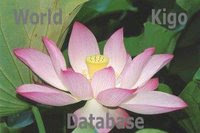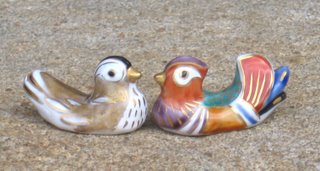:::::::::::::::::::::::::::::::::::::::::::::::::::::::::::::::::::::::::::::::::::::::::::::::::::::
The Dragon God protects Minuma !竜神が見守る実り 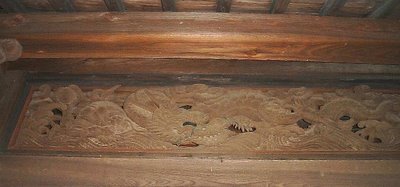 From a NHK program in September 2006.
From a NHK program in September 2006.
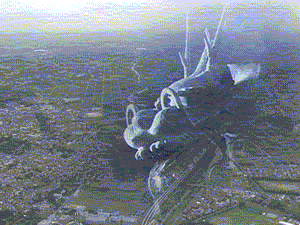 http://homepage2.nifty.com/minumafarm/
http://homepage2.nifty.com/minumafarm/The area of Minuma in Saitama Prefecture is known for its belief in the
God of Water (suijin), or rather the Dragon God (ryuujin).
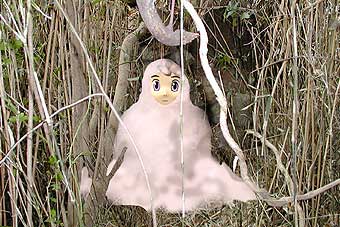
Here is a map of the area, which was a swamp in olden times and has been used for various agricultural cultivations since time of the eighth shogun, Yoshimune.
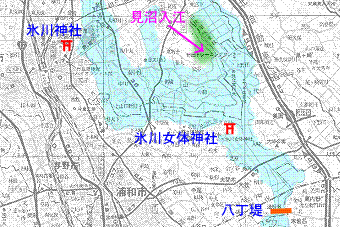 The Minuma Waterfront
The Minuma Waterfront
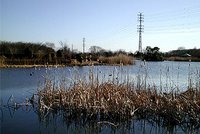
見沼入江・水神さま参詣
見沼代用水東縁の染谷~加田屋新田
http://www3.cnet-ta.ne.jp/c/cocone/omake/om033.html 龍神伝心
見沼田んぼ福祉農園
http://minumafarm.sports.coocan.jp/index.htmさいたま市見沼田んぼ:
竜神への祈りを欠かさない農家, 竜神に見守られて暮らす人々
http://homepage2.nifty.com/minumafarm/:::::::::::::::::::::::::::::::::::::::::::::::::::::::::::::::::::::::::::::::::::::::::::::::::::::
Dragon Dance 「竜頭の舞」 http://minumafarm.sports.coocan.jp/harunatu.htmThe Legend of the Dragon God.
http://minumafarm.sports.coocan.jp/harunatu.htmThe Legend of the Dragon God.The Hall of Dainichi Nyorai (Dainichi doo 大日堂) became the headquaters of the officials in charge of the water works in the swamp during the Edo Period. One night a fair maiden appeared in the dream of the official in charge, one
Izawa Yasobei, and told him she was the Lord of the Swamp. She asked Yasobei to postpone the constructions for 99 days in respect of the Lord Dragon God (which was herself) . After all, Yasobei had never asked her permission or given the Dragon God advanced warning to look for anothe place.
But the official had to follow his orders and work proceeded. Then Izawa fell ill and the works had to be stopped. Again the maiden appeared in his dream and asked for postponement. She would heal him if he agreed.
One day, when a servant peeked in his room, he saw his sleeping master, but next to him a white snake with a huge grinning open mouth, blowing fire on the sleeper. When he told his master, he immediately relocated the headquaters of his work force to another temple (Mannen-Ji 萬年寺) near Omiya.
The great tree (Castanopsis) in the compounds of the Dainichi Hall is a protector deity and prayed to for fertility and childbirth.
In a corner of the compound is a small shrine where the villagers pray to the Dragon God of the area for good harvest. Prayers also heal some coughing illness and when people are healed, they bring a rice ladle to the shrine as a thank you present (shamoji sama).
Nowadays, the ground around the Dainichi Hall is the playground for the local children and a festival in honor of the Dragon God is held there every year.
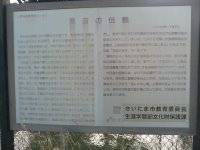
Click on the photo for enlargement.
http://www.kanshin.com/keyword/974271:::::::::::::::::::::::::::::::::::::::::::::::::::::::::::::::::::::::::::::::::::::::::::::::::::::
The Minuma Dragon
 http://www2.olff.net/minuma/mukasibanasi/mukasibanasi2.htm
http://www2.olff.net/minuma/mukasibanasi/mukasibanasi2.htm
Head like a camel, eyes like the demon, ears like a bull, horns like a deer, body like a snake, scales on the body like a carp, hands like a tiger and claws like a falcon.
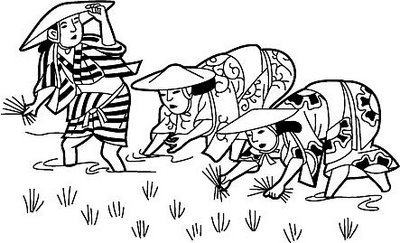 More about the Dragon Legend
More about the Dragon Legend
Japanese 日本語:::::::::::::::::::::::::::::::::::::::::::::::::::::::::::::::::::::::::::::::::::::::::::::::::::::
Quote from : Edo and Water TransportFrom a lecture at the 4th World Water Forum
by
His Imperial Highness the Crown Prince of JapanMarch 17,2006.Mexico
Let me tell you a little about Tokyo when it was still called Edo.
(1) Eastward diversion of the Tone RiverAs 17th century dawned, the warlord Tokugawa Ieyasu established the Edo Bakufu, or Shogunate. That was in 1603. Edo remained the seat of Tokugawa government until the Meiji Restoration in 1868. In establishing the Shogunate, Ieyasu embarked on a project to protect Edo from water hazards. In those days there were two rivers flowing through Edo, the larger of which was the Tonegawa, and the other the Arakawa, which was notorious for breaking its banks and overflowing. Nearby inhabitants thus were often exposed to the danger of flooding. Ieyasu diverted the Tonegawa in stages towards the east, separating it from the Arakawa to protect Edo from floods (fig-2). As a result of this initiative the Tonegawa now flows directly to the Pacific Ocean rather than into Tokyo Bay as it originally did. This was called “Tosen”, or the Eastward Relocation of the Tonegawa.
This is but one example of how our people managed the land to protect it from water hazards, whether overflowing rivers or high tides, making it habitable. As a consequence of similar interventions, (fig-3) 50% of all Japanese live on the alluvial plains which representing 10% of the country’s land area and where 75% of the nation’s assets are also concentrated.
(2) Development of Minuma Tamei
The diversion of the Tonegawa created vast wetlands (fig-4). The Minuma, which is today part of Saitama City in Saitama Prefecture adjacent to Metropolitan Tokyo, suffered a drop in its water level when the Tonegawa was diverted. In 1629, an 870 meter-long embankment was constructed to create a 1,200 hectare irrigation reservoir, called the Minuma Tamei. A local magistrate, Ina Tadaharu, directed the operation using a construction method known as “Kanto Ryu” or the Kanto Way (fig-5), which supplied water to the existing marsh. This contributed to the development of the area, particularly downstream of the embankment. However, with the expansion of cultivated land the water held in the reservoir was not always sufficient. At other times following torrential rainfall the rice paddies were submerged under water that overflowed from the reservoir.
Since the shogunate was established in the beginning of the 17th century, Edo became the preferred residential site for the shogun, some feudal lords and their vassals and families, as well as Buddhist monks and Shinto priests, and merchants, tradesmen and artisans. A century later, Edo had a population of over a million. Needless to say, there was a need to supply the large population of consumers. Goods supplied by sea from the commercial city of Osaka filled the gap but the newly developed agricultural hinterlands of Edo contributed as much.
At the time of the
8th shogun, Tokugawa Yoshimune (who lived from 1684 to 1751 and ruled from 1716 to1745), it was decided that new cultivatable land would be developed because the shogunate needed increased revenues. The possibilities offered by the Minuma Tamei reservoir could not be overlooked, and land reclamation by drainage was begun. The 8th shogun, who came from present day Wakayama Prefecture, appointed
Izawa Yasobei (born in 1654, died in 1738), an accountant of the shogunate and a civil engineer by training, to direct the design and operation of the plan. So, a 1,200 hectare rice paddy emerged where the 1,200 hectare reservoir had been.
(3) Minuma-dai Irrigation Canal
(fig-6) The embankment of the Minuma Tamei reservoir was demolished and the water was drained to the Arakawa River via the Shibakawa River (formerly a drainage canal). After the reservoir was drained to create new rice paddies, there was a need to tap another source of water for irrigation. For this, water would be drawn from the Tonegawa, and a 60-kilometer irrigation canal was constructed. The shogunate thus obtained sufficient water to irrigate a new area of paddy as well as the existing rice fields. The canal was called Minuma Dai-yosui - the Minuma Substitute Irrigation Canal.
Rice yield doubled with the completion of the canal compared to when the Minuma was marshland. At the same time, marshlands along the canal were also developed to become one of Japan's major rice-growing areas. Covering 15,000 hectares, it is known today as the
Minuma Rice Fields (Minuma Tanbo). Izawa Yasobei’s method of draining the marsh and digging a new canal and of separating irrigation water from waste water, was called the Kishu (Wakayama) way in contrast to the Kanto Way.
(4) Minuma Tusen Bori (barge canal)Izawa thought it necessary to link the vast agricultural area with the mega city Edo by water transport. However, while the Minuma Canal flowed strongly in its higher reaches, volumes were reduced farther down after the irrigation water had been drawn off, making it unsuitable for transport(fig-7). At the same time, the waste water canal became fuller as it flowed downstream and collected more drainage from the fields.
Izawa came up with the idea of connecting the irrigation canal with the drainage canal. The problem was that there was a water level difference between them of 3 meters. To overcome this discrepancy the Minuma barge canal was built (photo-5).
The canal was dug in 1731 to enable the passage of vessels between the drainage canal, the Shibakawa, and the two irrigation canals to the east and the west(fig-8). Japan’s first wooden two-stage lock gate was installed to solve the challenge of the 3-meter water level differential. Unfortunately, this lock gate has not survived. What we have today is a replacement. The barge canal, which overcame the 3 meter difference between the irrigation canals and the Shibakawa, became the most important means of transporting produce and other goods to and from Edo and the Minuma region. It was used mainly in winter when irrigation was not needed.
Rice, vegetables and timber were shipped out of the Minuma fields. From Edo went fertilizer, soy oilcake, fish and salt. Its most important export was fertilizer, which in those days was
night soil. It was called
‘golden fertilizer’ and was handled with respect. A special barge was built to transport this valuable commodity. Today, we would say it was recycled (fig-9). The golden fertilizer barges were in service even up to the Showa era (1926-1989).
So Edo, which by then had become a big city, was a recycling community. It was a remarkable feat, considering that elsewhere, as Victor Hugo was lamenting in “Les Miserables”, night soil was being dumped in the river. It is no surprise, then, that foreign visitors to Edo marveled at the cleanliness of the city.
Let me discuss the mechanical aspects of the Minuma Barge Canal (fig-10). 1) Two lock gates were built to overcome the 3-meter difference in the water levels of the Shibakawa River and the irrigation canal. 2) When the vessel passed through the first lock, manpower was used to pull the boat through the swift water of the canal (fig-11). 3) When the boat had passed the first lock gate, boards were placed to raise the water level. I will show you how it works (fig-12). A wooden board is thrown into the canal. The flowing water takes the board to the two pillars of the lock gate. The board has a handle that is caught with a long hooked rod and manipulated using the force of the water to a horizontal position between the two pillars.
The procedure is repeated until ten or so boards are in place one above the other. 4) The water level is thus raised high enough for the vessel to pass the second gate (photo-6). To lower the water level, the boards are removed one at a time by catching them with a hook as before (fig-13). Unlike the lock gates in Europe that are mechanically opened and closed, the manually operated system is uniquely Japanese. The Minuma Vessel Lock Gate is one that makes a unique contribution to world history.
(5) Edo Waterworks drawing from the Tama River (Tamagawa)Ensuring drinking water for its large population was a major challenge for Edo. The difficulty of penetrating the hard ground of the Kanto Plains was a formidable obstacle to exploiting the use of underground water. In the days when power was not available it was difficult to draw a large quantity of water from a nearby river as levels were usually too low. Water for drinking and household use therefore was drawn from lakes or farther upstream. The Kanda waterworks in Edo (fig-14) drew water from three lakes, Myoshoji, Zenpukuji and Inokashira, and supported the life of the Shogun and the city population.
Later, in 1654, the Tamagawa brothers operated the Waterworks drawing water from the Tama River. The water was abundant and was transported in an open channel over 43 kilometers from Hamura on the river where it was drawn to Yotsuya-Okido. At Senkawa and at other locations the water was diverted in catchments to supply the citizens of Edo, and without any doubt, contributed to the city's growth (fig-15).
The water used in Tokyo today is drawn from the same sluice from which the Tamagawa Waterworks drew and is distributed via the Yamaguchi and Murayama reservoirs. The Tamagawa Waterworks is no longer in service but the idea of drawing water at Hamura village on the Tama River for distribution is still viable. In 1962, a plan was announced to draw water from the Minuma irrigation canal to makeup for the shortage in Tokyo. It seems to me that, while no longer in service, the concepts pioneered in the Minuma Barge Canal and the Tamagawa Waterworks are still very much a part of our lives today. The canals in England that I had the pleasure to visit continue to live on with new roles, providing places for leisure and as sources of water. In France, the Midi Canal, registered in 1996 as a world heritage site, is in daily use while at the same time all its original mechanisms are preserved.
In ConclusionI have shared with you some illustrations of the special relations man has with water, with reference to the Thames, hinterland developments serving Edo, and water transport and waterworks that have contributed much to make the present-day Tokyo.
Water management represents a major challenge today. The solutions require an urgent commitment and cooperation in partnership among all members of the international community. But it must be noted that any solution to be effective must identify and meet the distinct needs of each region and every river basin. It is probably best found in the wisdom accumulated over millennia by local inhabitants. That is to say, only when regional traditions and histories are respected can solutions be truly useful.
When I stand by the Minuma Barge Canal, I feel that it is beckoning to us in Japan and elsewhere as we take on the challenges of water. One can surely find comparable pioneering achievements in every region of the world. To preserve them and draw inspirations from them seems to me the best way to find solutions wherever we are.
UNOFFICIAL TRANSLATION . Kunaichoo
http://www.kunaicho.go.jp/koutaishi/kouen-h18-01.html:::::::::::::::::::::::::::::::::::::::::::::::::::::::::::::::::::::::::::::::::::::::::::::::::::::
見沼(埼玉県川口市~さいたま市浦和区~大宮区~見沼区一帯)地区には龍神伝説があります。
江戸時代中期、見沼一帯の新田開発を進めていた幕府は利根川からの農業用水路を計画。
工事は伊沢弥惣兵衛の指揮の元大日堂に事務所を置いた。ある夜美しい女が弥惣兵衛の夢に現れ自分は見沼の龍神で工事を99日間延期して欲しいと言います。しかし工事は予定通り開始されてしまう。しかし弥惣兵衛が病気となり工事は進まなくなります。
再び現れた女は病気を治す代わりに願いを聞いて欲しいと告げます。弥惣兵衛の病気は良くなりますが、ある晩部下が弥惣兵衛の部屋を覗くと蛇身の女が弥惣兵衛の体を嘗め回していました。このことを聞いた弥惣兵衛は驚き事務所を片柳(大宮)の萬年寺に移しました。
大日堂の境内のシイノキは子宝にご利益があるといわれています。また大日堂の西側には村の鎮守の
天沼神社があり百日咳に霊験があるといわれ治るとシャモジを納めたところから「おしゃもじ様」 (杓文字) と呼ばれているそうです。
http://www.kanshin.com/keyword/974271:::::::::::::::::::::::::::::::::::::::::::::::::::::::::::::::::::::::::::::::::::::::::::::::::::::
田んぼは水を浄化し、気候を安定させ、酸素を供給し、地下水を潤し、連作障害を回避し、季節感を演出し、森林と同様に自然のダムになって私たちを水害から守る。アジアモンスーンの民は、田んぼとの関わりを肉体の中で記憶し、田んぼとの関わりの中で精神性を感得し、それを信仰の対象とまでしてきた。
見沼田んぼの龍神伝説も、その一つである。
http://minumafarm.sports.coocan.jp/mfsiki.htm::::::::::::::::::::::::::::::::::::::::::::::::::::::::::::::::::::::::::::::::::::::::::::::::::::
大宮の氷川神社の男体社に対して女体社と呼ばれ、間の中山神社を王子社とし、三社一体とされる。 □ 氷川神社が見沼の水神を祭ったであろうことは、この女体社によく現われている。神社の鳥居下に流れる見沼代用水は見沼が江戸時代に干拓されてから、文字通り見沼の代わりに潅漑の目的で掘割された用水である。
見沼が干拓されてからは、鳥居の前に沼に見立てた池の中に小さな島を造り、そこを祭祀場とする「磐舟祭」に代わった。
見沼の始めは縄文時代に海進が止まるまでは東京湾の海水で、その後、旧荒川の土石流による沖積作用で下流を塞ぐ自然堤防となり、流水は淡水の湖沼となった。江戸時代の始めに下流の潅漑用水を確保するため、幕府の代官頭伊奈氏によって見沼の一番狭い処に八丁堤と呼ばれた長さ八丁(880m)人工の堰を築き、用水の溜池とした。
この見沼が干拓されたのは
八代将軍吉宗の享保年間、新田開拓・増産奨励政策のなかで、沼の水をぬいて田畑とし、その潅漑用水として旧見沼の両縁に掘割された見沼代用水である。
神社の背後の微高地である三室に、この社の奥社とみなせる小室社の祠が祭られている。周辺の森の馬場小室山遺跡からの縄文後期から晩期の土器が多数出土していて、この地に早くから住み着き、また
水神が祭られていたかを示している。
http://www.ne.jp/asahi/hon/bando-1000/tam/tama/ara/r006/r006t.htmxxxxxxxxxxxxxxxxxxxxxxxxxxxxxxxxxxxxxxxxxxxx
大日堂のシイノキ The Big Tree at the Dainichi Hall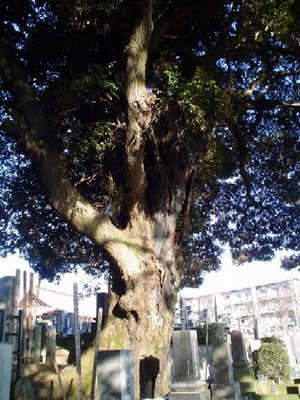 http://www.asahi-net.or.jp/~MZ3Y-KYM/kyoju/omiya-shii/dainichidou.htm
http://www.asahi-net.or.jp/~MZ3Y-KYM/kyoju/omiya-shii/dainichidou.htm:::::::::::::::::::::::::::::::::::::::::::::::::::::::::::::::::::::::::::::::::::::::::::::::::::::
Read Gabi Greve about
SUIJIN God of WaterRead Mark Schumacher about
Dragons, Dragon Art, and Dragon Lore
in Japan Buddhism and Shintoism:::::::::::::::::::::::::::::::::::::::::::::::::::::::::::::::::::::::::::::::::::::::::::::::::::::
Daruma Museum, Japan





















